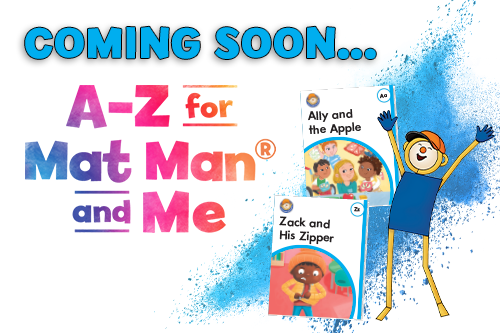Ask an OT | Mixed-Age Classrooms, Distance Learning, and Wood Pieces


Ask an OT is a monthly series answering questions that we receive from educators, parents and OTs, like you! Due to coronavirus, many schools are teaching children remotely or are adapting by keeping siblings together and forming mixed-age classrooms. Watch this month's video to learn some tips on how to best introduce handwriting to a mixed-age group of children ages 3-5, and learn how you can still use hands-on materials while teaching virtually. We’ll also show you how to use Wood Pieces for engaging readiness.
Have your own questions for our OTs? Send us a message on Facebook or Instagram!
Watch the full Ask an OT episode here and continue reading below for more advice on this month's topics.
Mixed-Aged Classrooms
Question #1: Hello! I am a Pre-K teacher, and I have been using your program for years and love it. Due to Covid, we are going to have siblings kept together, which means we’re going to have a mixed age classroom. I’m trying to decide the best way to introduce the alphabet to all the children. Do you have any advice in this area for me? Should I just go ahead and teach all of them the same way I would if they were in Pre-K beginning with the letter L?
One of the ways preschools have creatively managed to lower the risk of exposure to Covid is by keeping siblings together within a mixed age cohort classroom. While it may feel like a challenge to have mixed-age classrooms, there are actually many advantages. Students of mixed-age classes have the opportunity to interact with peers of varying ages to build social skills, older students learn patience to help younger students, and younger children may be self motivated to participate in more complex activities. A disadvantage of mixed-age classrooms is that children will naturally be at varying stages of development cognitively, physically, and social-emotionally. When it comes to teaching writing there are clear developmental differences between a three-year-old, four-year-old, and five-year-old because so much development happens during these years. Educators of mixed-age classrooms need to offer a variety of learning opportunities and developmentally appropriate experiences for children of all ages.
One easy solution is to structure the classroom day into whole-group learning, like circle time and small group learning, consisting of child-led centers and teacher-led centers. During child-led centers, children can engage in free-play to discover, explore, and interact with open-ended activities like sensory exploration, art supplies, blocks, and dramatic pretend play. During teacher-led centers, an adult is present to facilitate and direct learning instruction to groups of children the same developmental ages.
For example, during small group centers the teacher can teach Pre-K children how to form their letters based on the Get Set for School developmental teaching order of instruction inside of the Student Editions and Teachers Guides. During these Teacher-Led Centers, the teacher can teach older children how to form their letters and numbers and how to write their name. You can use the A+ Worksheet Maker to create custom worksheets and work on name writing with individual students. The letters can be taught out of order when teaching names.
While the Get Set for School curriculum was originally developed as a Pre-K curriculum, there are definitely many opportunities for younger children in a mixed-age classrooms to learn from Get Set for School’s child-friendly voice, multisensory lessons and hands-on materials.
Here are some activities that can be implemented into a mixed-age classroom for children of all ages:
- Get Set for School Sing Along CD: At first, just play the music during free time allowing the children to become familiar with the tunes and words. You can later use the favorite songs along with finger play during circle time or throughout the school day. A helpful tip is for the teacher to always point to the individual letters while singing the “Alphabet Song” to work on alphabet recognition. Don’t forget to check out a cute song called “There’s a Dog in the School” where three-year-olds can bark like a dog while the Pre-K children sing and point to the letters of the alphabet.
- Flip Crayons: Flip crayons are short crayons designed to promote good grip. Give children of all ages little crayons and blank sheets of paper to work on coloring. Three-year-olds will scribble, but they will eventually learn to make discrete lines which will lead to circles, shapes and letters as they enter Pre-K.
- Wood Pieces: Wood pieces are great for discovery play opportunities and through polishing, sorting, stacking and building mixed-age children will learn the Wood Piece names and attributes. During circle time, use Wood Pieces as a prop while singing songs like “Tap, Tap, Tap” and “Wood Piece Pokey” found on the Get Set for School Sing Along CD. When ready, older children can build letters with the wood pieces first using the Capital Letter Cards and then later on the blue Mat.
- Mat Man: During circle time the entire class can build Mat Man together using wood pieces, the Mat and accessories while singing the Mat Man song. Older children can then draw Mat Man during a teacher-led center.
- A-B-C Touch & Flip Cards: Three-year-olds can build the animal puzzle, even if they do not recognize letters yet by simply putting the fronts and backs of an animal together. Older children can say the name of the corresponding letter, finger trace the capital letter, go on a letter hunt, match capitals to capitals, and later progress to matching capitals to lowercase partners. The first letter that a young four-year-old will recognize is typically the first letter of their name. To bring meaning to letter recognition, give that child their letter card and show them how to complete a crayon rubbing by placing a sheet of paper over the tactile letter card and coloring.
- Roll – A – Dough: Children of all ages love to play with dough. And while pinching, squeezing, rolling, and pressing dough, they are working on fine motor small muscle development in their hands. During child-led centers, students can find small treasures hiding inside the dough or use random objects like jewels, pipe cleaners and beads to create a masterpiece inside of the blue tray. Together with a teacher, younger children can roll out big and little dough snakes and work together with the older children to place the dough pieces on the letter cards. Older students can progress to building a letter in the empty blue tray during Teacher-Led Centers.
Due to Covid-19, you will want to make sure you are following your school’s sanitizing procedures. Many hands-on manipulatives may need to be individualized for each child or cleaned immediately after use.
These are just some ways to utilize Get Set for School manipulatives with children of all ages. Use your creativity to think of more fun and engaging readiness activities. Remember that when it is time for Pre-K children to learn how to hold their crayon correctly to trace letters and numbers, the best place for instruction and learning will be in teacher-led centers. Within this smaller grouping the teacher can facilitate the Lesson Plans set forth in the Teacher's Guide to help four- and five-year-olds progress from crayon grip, coloring and drawing, tracing capital letters and numbers to writing lowercase letters and their name. While the daily Lesson Plans are specific for Pre-K children, the Week At-A-Glance Summary offers suggestions to adapt the activities for three-year-olds.
Teaching Handwriting Remotely
Question #2: Due to the Coronavirus, my school is teaching virtually this year through Zoom and Google Classroom. Do you have any tips for how to best teach handwriting to kindergartners while teaching remotely?
Remote or distance learning is occurring now more than ever due to the Covid-19 pandemic where children and teachers are thrust into virtual education behind computer screens rather than traditional face-to-face schooling.
Learning how to form and write letters continues to be an essential and foundational skill for all learning. Therefore teachers must adapt their strategies to teach handwriting remotely. Learning Without Tears is an award-winning curriculum, because we offer engaging, hands-on letter play opportunities that bring letters to life. Even without being in a physical school setting, there are many ways a teacher can successfully bring letter play opportunities into students’ homes through the virtual world of learning.
Here are some virtual teaching tips to make handwriting engaging and fun from behind a screen:
- Remember, you are the teacher, and you bring learning to life! Even remotely, it is important to provide direct, virtual instruction, and show children how to achieve writing success. Show children how to hold their crayons and pencils correctly, and use your webcam to demonstrate letter formation, using verbal cues like, “Watch me, it’s my turn,” before saying, “Now, it’s your turn.” Children can repeat the child-friendly letter formation steps together with you and even practice air writing letters before writing letters on paper.
- Music is magical! Use a variety of music to make your instruction fun and engaging. While children sing, tap, dance, and move to the catchy tunes, they are inherently learning grip, where to start letters, and more.
- Wood Pieces can be sent home to children with our Individual Student Manipulative Packs, or can be created using the template in our free, printable Pre-K Learning Pod Starter Pack. Children can imitate the teacher in wood piece play and build capital letters together.
- Use our online teaching tools, including the Pre-K Interactive Teaching Tool, and the Handwriting Without Tears Integrated Print and Digital Solution, coming in September. These digital teaching platforms use a variety of multimedia assets. While teaching remotely, you can share your screen to show digital letter and number formations, instructional videos, music, engaging animations, and more. In addition, the Integrated Print and Digital Solution offers a simple way for teachers to assign handwriting lessons to children during remote learning and allows children to submit their assignments online wherever they are learning.
- If children do not have access to the Student Edition workbooks at home, they can practice writing on homemade double-lined paper made on a blank sheet of paper using a ruler. Or students can practice letters using A+ Worksheet Maker Lite which is a free resource for creating individualized worksheets using the Handwriting Without Tears font on double-lines.
- Combine powers and work together with parents to facilitate school to home learning. The teacher will virtually provide direct instruction, but the parents can champion success through practice at home using the At Home Learning Packets which are a free download offered in English or Spanish.
- Spice up your virtual classrooms with fun Learning Without Tears Zoom backgrounds, starring Mat Man, Magic C Bunny, and more!
- If teaching in a hybrid model where children take turns being in the classroom and at home, focus on providing active instruction in the classroom using the Student Editions, then provide practice opportunities at home on double-lined paper and using the A+ Worksheet Maker.
Remember, Learning Without Tears is here to support your teaching needs! You can check out the many Distance Learning resources available at your fingertips to make learning fun, memorable, and hands-on even while teaching remotely!
Using Our Wood Pieces
Question #3: I understand how to use Wood Pieces to build capital letters, but my four-year-old is not interested in letters yet. Do you have tips on other Wood Piece activities to spark his interest before building capital letters?
Wood pieces are one of the most popular hands-on learning opportunities to build capital letters and numbers. But did you know that there are tons of readiness activities that use Wood Pieces prior to building letters?
Before we dive into Wood Piece play, let me introduce to you their very special names: Big Line, Little Line, Big Curve, Little Curve. To help children remember the names of the Wood Pieces, try introducing their names with silly voices for example use your big loud voice for saying “Big Line,” and your little squeaky voice for “Little Line.” It is important to always call Wood Pieces by their appropriate names, and never call them sticks. Why? Because children hit with sticks, and we do not form our letters with sticks. Instead we form them with the strokes: “Big Line, Little Line, Big Curve, and Little Curve.”
Prior to teaching children how to build their letters with Wood Pieces, children can play using Wood Piece readiness activities. Here are a variety of ways to engage in Wood Piece play:
- Music is a powerful and memorable way to introduce Wood Pieces. Get your tapping needs out while tapping your Big Lines to “Tap, Tap, Tap,” and learn positions in space, body parts, and the names of the various Wood Pieces while dancing along to the “Wood Piece Pokey.”
- Free play is a great opportunity to build, sort, and trade with Wood Pieces. Watch children add toy cars to their building creations as they make elaborate racetracks and highways using Wood Pieces.
- Play “Shake, shake, shake! What’s in the bag?” by placing a variety of Wood Pieces in a bag, and ask children to use tactile discrimination skills to identify the different pieces by touch and not by sight. To make this activity easier for the youngest learners, only place one type of Wood Piece in the bag. When working with older students, place a variety of Wood Pieces, and even other items, like a fork, into the bag to see if they can identify the correct Wood Piece.
- “Simon Says have your Big Line touch your nose!” Simon Says is a fun game to work on following directions, but also it can be played to learn the names of body parts or positions in space. Temple Grandin, a woman with autism and an expert in the field of autism says that she “thinks in pictures.” So learning nouns is easy, but learning positional words can be difficult. Therefore, teach spatial words like over and under using Wood Pieces to help visualize the meaning to these position words.
- You can embellish your Wood Pieces by texturing them with sidewalk chalk paint, birdseed, sandpaper, and more. To make them glow in the dark with a black light, try painting the Wood Pieces with florescent color paint. If you do not want to alter your Wood Pieces, you can easily make your own Wood Pieces using the template in our free, printable Pre-K Learning Pod Starter Pack using cardboard boxes, foam board, and even sandpaper.
- Mat Man is a favorite classroom hero that can be built with Wood Pieces, the blue Mat, and accessories. Building Mat Man helps a child learn about body awareness, sharing and even drawing a picture of a person. Visit Mat Man World to learn more about Mat Man.
As you can see, Wood Piece play opportunities are endless. Share with us some of your favorite Wood Piece activities and Mat Man creations on Learning Without Tear’s Social Media: Facebook, Instagram, Twitter.
A—Z for Mat Man and Me
Order Now!
Seamlessly bring the ABCs to life while building foundational literacy skills with our new letter book series. Each of our illustrated letter books introduces a letter of the alphabet and emphasizes their associated sound through captivating, visual stories. The engaging stories in each book capture children's imaginations and expose them to social-emotional skills and diverse cultures.
You can Learn More → .



